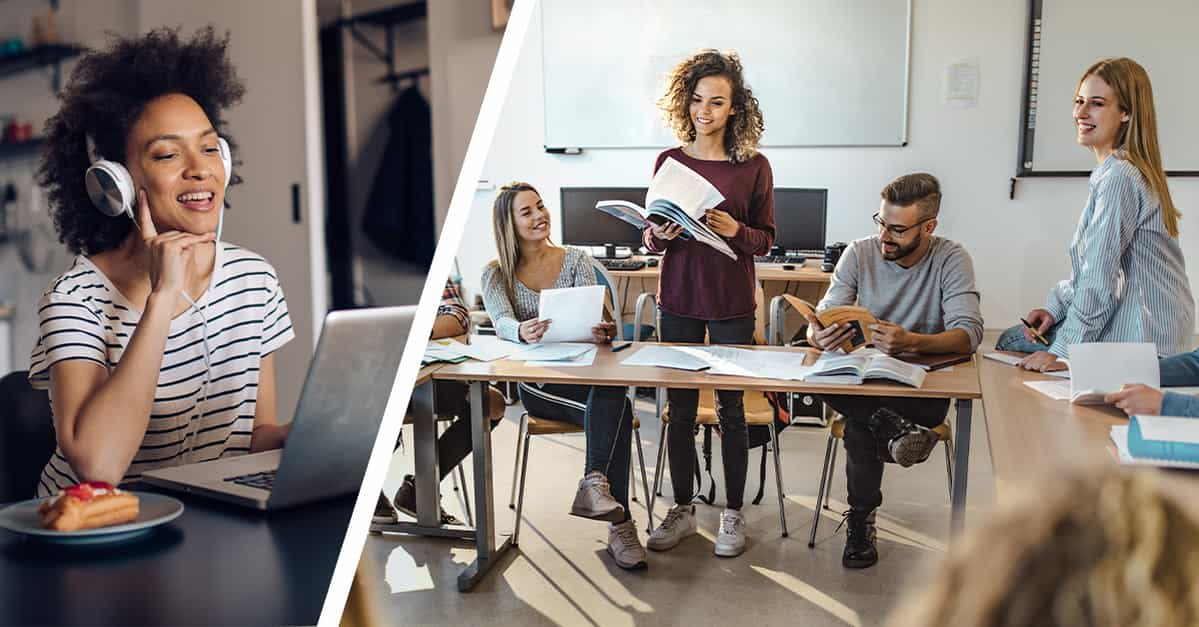8 remarkable benefits of hybrid learning (that go beyond COVID-19)

Posted by Tricia Whenham on Jul 13, 2022 6:00:00 AM
“Adaptability is the simple secret of survival.” These words from Jessica Hagedorn hit close to home. In 2020 when colleges and universities were faced with the unprecedented challenge of a worldwide pandemic, they pivoted on the fly and in the process made an accidental discovery — hybrid learning really works.
Of course, hybrid learning advocates knew this long before COVID-19. But now the approach — which blends in-person and remote class attendance — has gone from niche to mainstream. In fact, 93.7% of higher education professionals surveyed think hybrid options will be part of the higher ed landscape well into the future.
Traditional in-person classes aren’t going anywhere. For some students, face-to-face is how they learn best. And certain types of courses and programs simply don’t work at a distance. But offering hybrid alternatives can better meet the needs of a diverse range of students while also keeping your institution adaptable. Here are 8 benefits of hybrid learning to keep in mind.
1. Better engagement
Despite what some may think, participation doesn’t need to be sacrificed in a hybrid class. In fact, nonconventional communication methods — like a backchannel that lets students type their comments and questions — may actually make it easier for introverts to engage. Incorporating some hybrid-focused learning activities or icebreakers can also set the right tone early on.
2. More options for students
For some students, emergency remote learning during the pandemic was a disaster. But for others, it was a revelation. Creating hybrid classrooms means students can choose to learn in ways that work for them — in person or remote. For example, some neurodiverse students have an easier learning experience when they can connect from their home environment.

3. Flexibility for instructors
Hybrid learning creates much needed flexibility for faculty as well. If professors travel frequently — for conferences or research trips — they may wish to teach remotely rather than cancel class. Others may be forced to connect from home due to a mild illness or recovery from surgery. Hybrid instruction isn’t always viable, but the right setup can give everyone options.
4. Increased accessibility
A traditional college or university course load can throw up barriers for some. With hybrid learning options, students juggling jobs or childcare have one less ball in the air. Skipping the commute to campus also makes it easier to fit in medical appointments, and students can avoid having to tackle dangerous roads during snowstorms or other inclement weather.
5. Healthier campuses
In the wake of the pandemic, no one wants to go back to a time when germs are spread freely. But what happens when a student has a cold or cough? It isn’t fair to leave them with the impossible choice of coming to class (and spreading their illness) or staying home and missing out. With hybrid options, they can join remotely if they’re too sick to be in the classroom but not too sick to learn.
6. Access to guest scholars
A hybrid learning setup has the added advantage of facilitating different kinds of remote connections. Guest lecturers can join classes from anywhere, opening students up to a broad range of expertise that might be hard to come by. Hybrid tools can also help students connect with mentors from their field of study, bridging the gap between the classroom and the rest of the world.

7. Hybrid workforce preparation
Students leaving college or university are entering a different work world than the one that existed pre-pandemic. Knowledge workers in particular will need to understand how to thrive in the hybrid workforce. Hybrid learning helps prepare students to participate actively in hybrid meetings, plus they’ll likely get more experience using asynchronous communication tools to work with others.
8. Readiness to pivot again
If we’ve learned anything over the past few years, it’s that those who adapt fast gain an enormous advantage. Hybrid learning keeps you flexible, so you’re ready for anything that might come. Hopefully we’ll never go through a repeat of March 2020, but if we do, the ability to quickly pivot means less disruption for everyone.
Setting up for success
What do you need to make hybrid learning a success? It helps to have edtech products that are simple and flexible — and that don’t take up inordinate amounts of IT time.
When it comes to audio, you need a product that reliably picks up every voice in the classroom. Students who are remote should be able to hear the comments and questions of those who are in the classroom — without the need to pass around a mic or have an instructor repeat what they said. It also helps to have automated camera switching and voice amplification. If you’re looking for an easier way to accomplish this, here’s how we can help.
Flexible tools for exceptional learning
Discover the easiest and most cost-effective way to equip your classrooms for engaged hybrid learning. Nureva® audio systems ensure that student and instructor voices are picked up in every inch of the classroom — with no need for expensive multicomponent setups.
Editor’s note: This post was originally published July 2022 and has been updated.

Posted by
Tricia Whenham
July 13, 2022
















